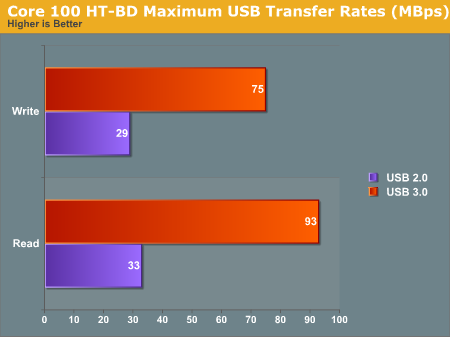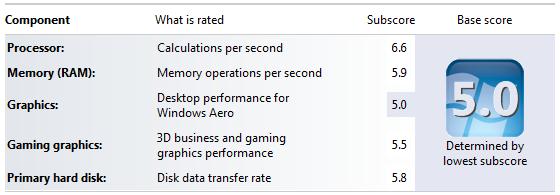ASRock Core 100HT-BD : Bringing HTPCs to the Mainstream Market [UPDATED : Noise Issue]
by Ganesh T S on July 19, 2010 9:34 PM EST- Posted in
- Home Theater
- Arrandale
- ASRock
- Media Streamer
- Core i3
- HTPC
Do the usual benchmarks really provide us with a proper indicator of the worthiness of a HTPC? Is that the performance seen by an average user in real life situations? Such questions often crossed my mind when I looked up the reviews of PCs on various websites. It is almost blasphemous if one were to suggest that the 'Windows Experience Index' is a reflection of what the average user sees. Such a synthetic benchmark might not be a true reflection of the capabilities of the system, but it at least gives an idea to the users as to how much better the system would be compared to the one they currently possess. HTPCs require a different set of performance measurement tests, and we will handle them in the next set of sections. In this, however, we will talk about the general performance metrics in brief.
For readers wanting a lowdown on the core performance aspect (in other words, graphs for various standardized benchmarks) of the motherboard used in this PC, I would suggest reviews from Legion Hardware and Benchmark Reviews. We found nothing in our experiments to dispute their findings. However, one important aspect we would like to cover here is the USB 3.0 performance.
USB 3.0 on the HM55 Chipset
We hooked up OCZ's Enyo 128 GB USB 3.0 external SSD (which has received glowing reviews everywhere with upto 200 MBps read and 190 MBps write speeds) to the front USB 3.0 ports of the Core 100 HT-BD. Contrary to our expectations, we managed to get a maximum of only 93 MBps read and 75 MBps write performance out of the drive. Connecting the same SSD to an USB 2.0 port resulted in a maximum of 33 MBps reads and 29 MBps writes, in line with expectations. We do not get the fabled 10x, but only a 2.7x, improvement over USB 2.0 with the Core 100 HT-BD's USB 3.0 implementation.

A little more analysis revealed that the HM55 chipset does not support PCI-E v2 fully and the bandwidth is limited by the chipset. To get around this limitation, ASRock could have placed a PLX bridge chip on board. We covered this workaround in detail in an earlier piece, but it doesn't make sense for ASRock to implement it in this product. The existing limitation will not be of concern to most users, as SSDs are yet to go mainstream (because of their cost). Most external hard disks with USB 3.0 or eSATA interfaces are inherently limited by the disk-to-buffer transfer rate of around 70 - 90 MBps, and ASRock's USB 3.0 implementation is capable of handling such bandwidth.
Windows Experience Index
A quick glance through the specifications of the system easily reveals the bottleneck affecting the score on the Windows Experience Index. It is none other than Intel's integrated GPU which ends up being the culprit. A screenshot of the Windows Experience Index shows the system chiming in at 5.0. However, we have seen the scores oscillate between 4.4 and 5.2 depending on the graphics driver version, as well as the GPU overclocking status.

Of particular interest is the impressive score received by the processor (6.6), indicating that the performance of this unit would be more than enough for most, if not all, HTPC applications.
DPC Latency Check
Another important criterion for HTPCs is the ability of the system to handle real time streaming of audio and video without dropouts. A handy tool called the DPC Latency Checker helps in analyzing this. This tool was run multiple times in various HTPC scenarios. We did observe red spikes, but disabling the C-states, as well as SpeedStep in the BIOS Advanced CPU configuration helped in alleviating the issue. However, we did not observe any dropouts or playback issues with Blu-Ray or any other media despite the sporadic occurrence of these spikes.
Miscellaneous Performance Indices
Pre-built HTPCs available today are mostly based on the ION chipset, and any comparative evaluation of the benchmark results of this system with ION systems would be grossly unfair for the ION. Both Benchmark Reviews and Legion Hardware compared the Core 100 HT with the ION 330, the 2009 HTPC model from ASRock. Comparing the performance of the Atom to the Core i3 is like comparing apples to oranges, but, for the record, the Core 100 HT system came out better on almost all counts except for the 3D and gaming performance.
On the memory bandwidth side, the Core 100 has more than 2x the performance of the ION 330. CPU performance is around 4 - 5x better. While games appeared to achieve almost similar frame rates on both the Core 100 and the ION 330, 3D performance in applications such as Maya went down by a factor of 2x in favour of the ION 330. Thankfully, applications such as video encoding (a common overnight task for most HTPCs) see a 3.5x performance improvement in the Core 100HT-BD.
In the next section, we will look at the integrated GPU of the Core i3-330M in detail.










107 Comments
View All Comments
Lostclusters - Sunday, July 25, 2010 - link
I know the review mentioned things like "Perfect Blu-Ray playback with bitstreaming", and "able to play back all Blu-Rays with bitstreaming to the AV receiver", but there is no mention of whether the sound is at 24 bits or 16 bits. I am sure that the same limiting factors as any other PC comes into play. But as I am currently not very well informed on Windows 7, I'd like to see some mention of this in the review. Both with LPCM and native codec.ganeshts - Monday, July 26, 2010 - link
Lostclusters,The bitstreaming is perfect. This means whatever bit resolution is present in the soundtrack is passed on as-is, with no downsampling of any sort.
Its HDMI can pass through Dolby True HD and DTS HD Master Audio up to 192KHz/24-bit , whereas absence of passthrough would mean support for only Dolby or DTS 48KHz/16-bit audio quality.
Even on the other sound channel, i.e, VIA VT2020 codec, there exists support for Blu-ray audio up to 7.1ch 192KHz/24-bit audio with content protection.
Lostclusters - Sunday, July 25, 2010 - link
I forgot to mention that this should be examined not only when playing off a Bluray disk but when playing files off the hard drive as well.Lostclusters - Monday, July 26, 2010 - link
Another item not addressed (maybe in the bench marks) is was how it performed an SD media. I know the screen resolution is locked in at 1080. But how well does it play SD media?ganeshts - Monday, July 26, 2010 - link
Lostclusters,While I agree that the majority of the streams in the test suite were HD (after all, that is the future), we do have 5 - 6 SD streams (evident from the file names).
What you may be looking for is the upscaling capabilities of the GPU / software. I didn't pay much attention to this, but things didn't look horribly wrong. So, I would say that it is good enough to play SD media also. I am unable to think of a metric which will give you a quantitative view of the capability.
Lostclusters - Monday, July 26, 2010 - link
Check out this link at the bottom of the post under the heading of "My Pick of HTPC":http://www.avsforum.com/avs-vb/showthread.php?p=18...
LNCPapa - Monday, July 26, 2010 - link
This device really appeals to me - I was seriously considering going with a Mac Mini + Plex but with the price changes I figured I might as well not give Apple any more my money. By the way - great link post LostCluster - That thread was an awesome read and that guy has done an incredible amount of research.If this device had/would launch at a $500 price point I would purchase it now and ask the wife for forgiveness later.
ganeshts - Monday, July 26, 2010 - link
NewEgg seems to have the non-BluRay model for $580 + shipping:http://www.newegg.com/Product/Product.aspx?Item=N8...
Lostclusters - Monday, July 26, 2010 - link
I have been following Rene's work since his first recommendation on hardware. I have even donated to his work. He is one dedicated individual and has several threads on that forum. Many many good threads there. Chocked full of info.Decaff - Tuesday, July 27, 2010 - link
I really enjoyed reading through this article, as I am myself looking for a media streamer solution. I do, however, have some points of inquiry.First of all, the picture quality testing should be figured out. I have seen television review sites who do regular testing of the picture quality. I know that much of this is a often subjective, but I still think it is paramount that this is analysed, as many home theater enthusiasts are highly sensitive to the picture quality. I do think the use of the HQV test is a good starting point, but I still think subjective measures are in order, as a means of relating the numbers to any percieved loss of quality.
In essense, the people investing in HTPC's of media streamers will probably also have a quality TV-set/projector attached to it. So the framerate issue could naturally be a killer for many enthusiasts, as I know this particular issue has been discussed on many TV forums, where they are very concerned with configuring the TV properly to the correct framerate in order to achieve the right picture quality.
Perhaps an alliance with a site that specialises in reviewing picture quality of TV sets?
Secondly, I think you should be more aware of what software you are using on the machine. Naturally, Anandtech is largely a hardware site, but when dealing with a media streamer/HTPC it is essentially the software that defines the final user experience of the setup. Essentially, if I have just bought a HTPC, I don't want to be pestered with 3 different programs in order for the box to do its job. Rather I (and presumably almost everyone else) wants a nice interface that can handle all the tasks the box it built for, preferably using only the remote control, and the occasional keyboard/mouse when performing tasks that are PC-centric.
So my suggestion is to make a large article with HTPC software, where you look at the features it offers, ease of use, and naturally and in relation to my first point, the output quality of them.
Lastly, I'm really looking forward to seeing some reviews of more dedicated (smaller and cheaped) streamer boxes, such as the WDTV live, A.C. Ryan Playon!HD or the Popcorn machines and naturally also a comparison with the gaming consoles as the Playstation 3 or the Xbox 360 and how they fare in comparison, regarding codec support, and of course in the area of picture quality and ease of use.
These last are at the moment those that interest me the most, as I just want a box that can play my movies from an external HDD or a NAS/Home Server, without all the extra stuff (although it is of course nice to have), and I suspect a great deal of people have similar demands and can use another PC to rip their movies.